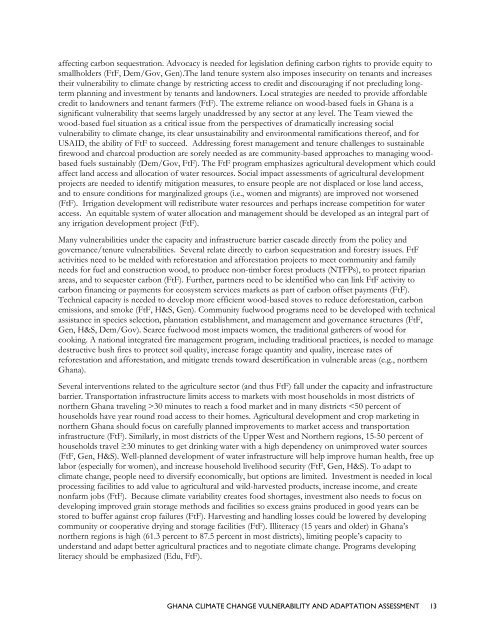ghana climate change vulnerability and adaptation assessment
ghana climate change vulnerability and adaptation assessment
ghana climate change vulnerability and adaptation assessment
- No tags were found...
You also want an ePaper? Increase the reach of your titles
YUMPU automatically turns print PDFs into web optimized ePapers that Google loves.
affecting carbon sequestration. Advocacy is needed for legislation defining carbon rights to provide equity tosmallholders (FtF, Dem/Gov, Gen).The l<strong>and</strong> tenure system also imposes insecurity on tenants <strong>and</strong> increasestheir <strong>vulnerability</strong> to <strong>climate</strong> <strong>change</strong> by restricting access to credit <strong>and</strong> discouraging if not precluding longtermplanning <strong>and</strong> investment by tenants <strong>and</strong> l<strong>and</strong>owners. Local strategies are needed to provide affordablecredit to l<strong>and</strong>owners <strong>and</strong> tenant farmers (FtF). The extreme reliance on wood-based fuels in Ghana is asignificant <strong>vulnerability</strong> that seems largely unaddressed by any sector at any level. The Team viewed thewood-based fuel situation as a critical issue from the perspectives of dramatically increasing social<strong>vulnerability</strong> to <strong>climate</strong> <strong>change</strong>, its clear unsustainability <strong>and</strong> environmental ramifications thereof, <strong>and</strong> forUSAID, the ability of FtF to succeed. Addressing forest management <strong>and</strong> tenure challenges to sustainablefirewood <strong>and</strong> charcoal production are sorely needed as are community-based approaches to managing woodbasedfuels sustainably (Dem/Gov, FtF). The FtF program emphasizes agricultural development which couldaffect l<strong>and</strong> access <strong>and</strong> allocation of water resources. Social impact <strong>assessment</strong>s of agricultural developmentprojects are needed to identify mitigation measures, to ensure people are not displaced or lose l<strong>and</strong> access,<strong>and</strong> to ensure conditions for marginalized groups (i.e., women <strong>and</strong> migrants) are improved not worsened(FtF). Irrigation development will redistribute water resources <strong>and</strong> perhaps increase competition for wateraccess. An equitable system of water allocation <strong>and</strong> management should be developed as an integral part ofany irrigation development project (FtF).Many vulnerabilities under the capacity <strong>and</strong> infrastructure barrier cascade directly from the policy <strong>and</strong>governance/tenure vulnerabilities. Several relate directly to carbon sequestration <strong>and</strong> forestry issues. FtFactivities need to be melded with reforestation <strong>and</strong> afforestation projects to meet community <strong>and</strong> familyneeds for fuel <strong>and</strong> construction wood, to produce non-timber forest products (NTFPs), to protect riparianareas, <strong>and</strong> to sequester carbon (FtF). Further, partners need to be identified who can link FtF activity tocarbon financing or payments for ecosystem services markets as part of carbon offset payments (FtF).Technical capacity is needed to develop more efficient wood-based stoves to reduce deforestation, carbonemissions, <strong>and</strong> smoke (FtF, H&S, Gen). Community fuelwood programs need to be developed with technicalassistance in species selection, plantation establishment, <strong>and</strong> management <strong>and</strong> governance structures (FtF,Gen, H&S, Dem/Gov). Scarce fuelwood most impacts women, the traditional gatherers of wood forcooking. A national integrated fire management program, including traditional practices, is needed to managedestructive bush fires to protect soil quality, increase forage quantity <strong>and</strong> quality, increase rates ofreforestation <strong>and</strong> afforestation, <strong>and</strong> mitigate trends toward desertification in vulnerable areas (e.g., northernGhana).Several interventions related to the agriculture sector (<strong>and</strong> thus FtF) fall under the capacity <strong>and</strong> infrastructurebarrier. Transportation infrastructure limits access to markets with most households in most districts ofnorthern Ghana traveling >30 minutes to reach a food market <strong>and</strong> in many districts
















